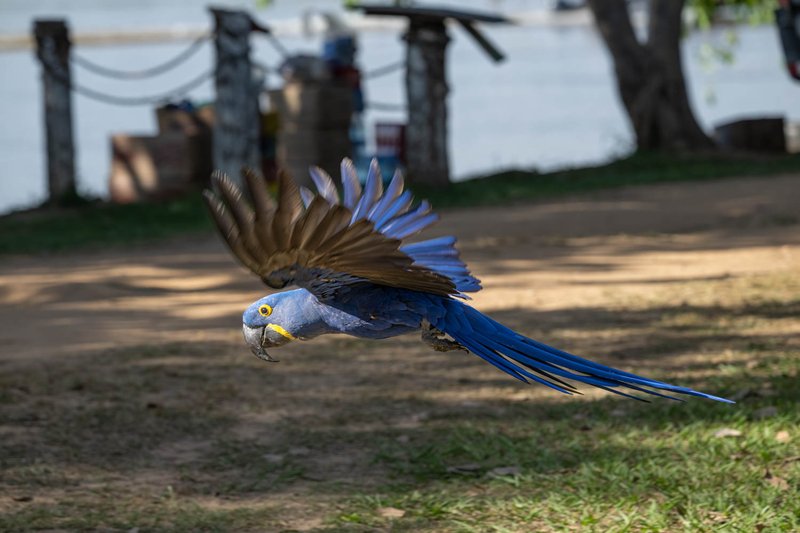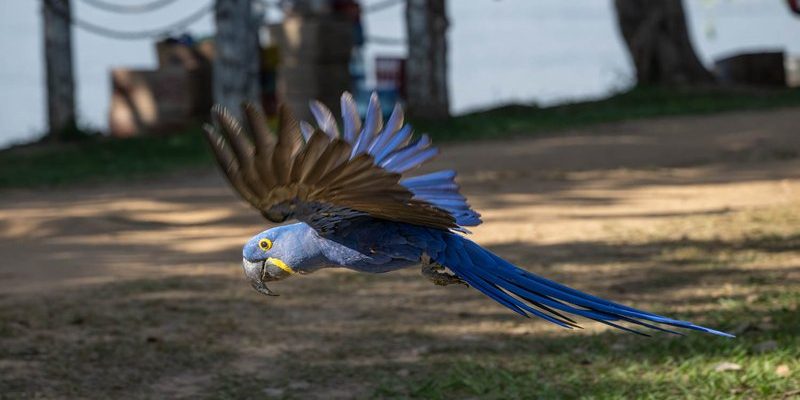
Imagine each flap of its wings like an artist’s brush stroke, creating a masterpiece in the sky. The hyacinth macaw doesn’t just fly; it dances on the wind. And when it comes to hunting and foraging, this bird employs unique techniques that set it apart from other species. So, let’s dive into the world of these magnificent macaws and discover how they navigate their habitat and secure their meals.
Understanding the Hyacinth Macaw’s Flight
The hyacinth macaw is renowned for its impressive wingspan, which can reach up to 4 feet. But it’s not just about size; it’s also about how they use those wings. You might be wondering what makes their flight so special. The secret lies in their strong, broad wings that allow for soaring glides and effortless maneuvers through dense forests.
These birds typically fly at about 10 to 20 miles per hour, but they can reach speeds of up to 30 miles per hour in short bursts. Their flight style is characterized by a series of powerful flaps followed by gliding. This technique conserves energy, which is important when flying long distances in search of food or mates. When you see a hyacinth macaw in the air, it’s like watching a ballet performance—every movement is deliberate and graceful.
Interestingly, these macaws are also highly social creatures. They often fly in pairs or small groups, which adds to their beauty in the sky. Flying together not only strengthens their bonds but also helps in spotting food or avoiding predators. Honestly, it’s a spectacular sight!
Foraging Strategies: How Hyacinth Macaws Hunt
Now that we’ve covered their flight, let’s talk about how the hyacinth macaw hunts for its food. Unlike some birds that may swoop down on their prey, these macaws have a different approach. They primarily feed on fruits, nuts, and seeds, particularly favoring the hard seeds of palm trees. Their favorite snack? The tough fruits of the Brazilian palm tree, which requires a bit of finesse to access.
To get to their meals, hyacinth macaws use their powerful beaks, which are designed like nature’s own nutcrackers. With just the right amount of pressure, they can crack open even the toughest shells. It’s one of the reasons why they thrive in their natural habitat—these birds are built to handle what nature throws at them.
You might picture them hanging upside down or using their feet to hold onto branches while they work on a particularly stubborn nut. This dexterity gives them a unique edge, allowing them to explore their environment thoroughly while searching for food. Here’s the thing: they also have incredible vision, which helps them spot their favorite snacks from afar.
The Role of Social Hierarchies in Hunting
Hyacinth macaws are not solitary when it comes to foraging; they often hunt in groups. This social aspect plays a significant role in their hunting efficiency. By working together, they can cover more ground and locate food sources more quickly. Picture a group of macaws spreading out among the trees, with each bird using its keen eyesight to find their next meal.
Within these groups, there’s often a social hierarchy. Dominant birds may feed first, while others wait their turn. This behavior not only helps maintain order during feeding times but also teaches younger macaws which fruits or trees are the best sources of food. Honestly, it’s almost like a family dinner, where everyone has their place and role.
Moreover, their social nature comes into play when defending their territory. When one macaw spots a potential threat, it can quickly alert the group. This teamwork helps keep the flock safe and ensures that everyone gets a chance to eat. Imagine a party where everyone looks out for each other—that’s the essence of hyacinth macaw social life!
Adaptations for Survival
Survival in the wild isn’t just about hunting; it’s also about adapting to challenges. Hyacinth macaws have several fascinating adaptations that help them thrive in their natural habitat. For starters, their strong beaks are not only great for cracking nuts but also serve as tools for climbing and navigating their tree-dominated environment.
Additionally, their vibrant plumage plays a crucial role in their survival. These bright colors may seem like eye candy, but they also help camouflage the birds among the leaves and shadows of their forest homes. It’s like wearing a protective outfit that makes it harder for predators to spot them.
Also, let’s not forget about their intelligence. Hyacinth macaws are known for their problem-solving skills. If a particular food source is scarce, they can learn to use tools or find alternative food sources. This adaptability is vital for their survival, especially in changing environments or during food shortages.
Conservation Efforts and Their Importance
As stunning as the hyacinth macaw is, it faces threats that put its survival at risk. Habitat loss due to deforestation, the illegal pet trade, and hunting have all taken a toll on their populations. Understanding these challenges is essential if we hope to protect these magnificent birds.
Conservation efforts are underway to help preserve their habitats and educate people about the importance of these creatures. Organizations are working to save the areas where hyacinth macaws thrive, ensuring they have safe places to nest and forage. Additionally, raising awareness about the illegal pet trade can help reduce demand, protecting these birds in the wild.
Every little bit counts when it comes to conservation, and supporting these initiatives can help secure the future of the hyacinth macaw. It’s not just about saving a species; it’s about preserving a piece of our planet’s incredible biodiversity.
Why Hyacinth Macaws Are Fascinating Creatures
In all, the hyacinth macaw is a remarkable blend of beauty and skill. From their impressive flight techniques to their unique hunting methods, these birds captivate anyone lucky enough to observe them. Their social structures, adaptability, and conservation needs remind us of the delicate balance in nature.
If you find yourself fascinated by the hyacinth macaw, you’re not alone. These birds serve as a reminder of why we should cherish wildlife and work towards protecting it. Honestly, watching them fly through the trees can inspire a sense of wonder and appreciation for the natural world.
So, the next time you hear about these stunning macaws, take a moment to think about their incredible journey through the skies and their equally impressive strategies for finding food. Remember, every effort counts in making sure future generations will see these beautiful birds soaring gracefully above.

